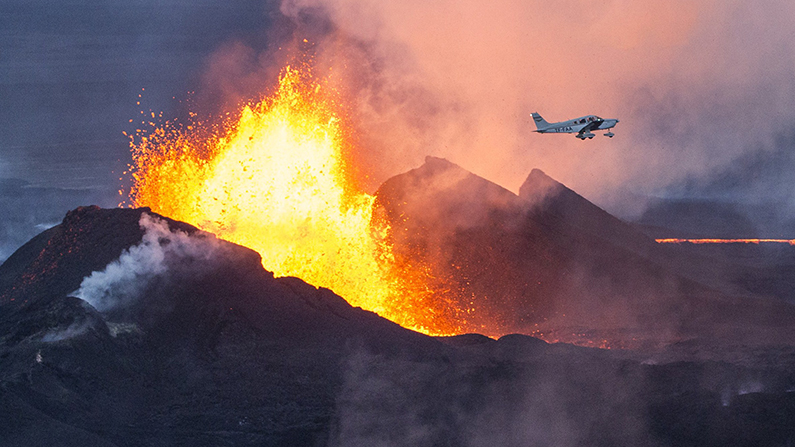Iceland’s biggest volcano has been shaken by a series of earthquakes in the past week, possibly presaging an eruption.
The 6,590-foot Bardarbunga volcano, buried underneath the Vatnajökull glacier, has been hit with four quakes. According to Pall Einarsson, a geophysicist at the University of Iceland, this shows that pressure in the volcanoes magma chamber is increasing.
Bardarbunga is one of the most active of Iceland’s 130 volcanoes. It last erupted in 2014, spewing lava and ash over Iceland’s highlands for nearly six months. The eruption released half a cubic mile (4.6 trillion pounds) of ash and rock.
What has people concerned is the possibility of an eruption like that of the Icelandic volcano Eyjafjallajökull in 2010. That event sent plumes of fine ash so high into the sky it interrupted air travel.
That eruption left 10 million air travelers stranded and cost the European economy an estimated $4.9 billion.
Not everyone is worried.
Dr. Gunnar Gudmundsson from the Icelandic Meteorological Office said, “There are no signs it will erupt imminently.”
Gudmundsson said the four quakes, which shook the Vatnajoekull ice cap were relatively small, measuring 3.9, 3.2, 4.7 and 4.7 on the Richter scale. He also said more small quakes could be expected.
“Probably in the coming weeks there will be some more earthquakes. We cannot predict but it’s unlikely Bardarbunga will erupt as a result,” he said.

Dr. Simon Day, of University College London, said the activity could “precede a large explosive eruption and consequent widespread ash fall,” but claimed it is “statistically unlikely.”
“It’s not very likely that the current activity will lead to an eruption breaking the ice or erupting along the rift zone,” he said.
“A lot more has to happen before the current seismic activity develops into a major eruption and the chance of it doing so is statistically quite small, of order 1 in 100.”
The earthquakes are most likely caused by magma—molten rock—moving in the chamber under the cone of the volcano, according to Oregon State University. The magma presses on cracks in the roof of the chamber, causing small shifts in the rock—small earthquakes.
‘The reason for the earthquakes in this place is that the volcano Bardarbunga is inflating, i.e. the pressure of magma in the magma chamber is increasing It has been doing this since the last eruption ended, in February 2015,” said Einarsson.
”The volcano is clearly preparing for its next eruption, that may happen in the next few years.”
The Icelandic Meteorological Office has listed activity levels at the volcano as ‘high’ but has not yet issued a warning.

Record-Breaking Eruption
The 2014 eruption of Bardarbunga was the most powerful recorded in 240 years.
That eruption began in August 2014 and lasted until February 2015.
Iceland’s Meteorological Office issued a “red alert” in August 2014, anticipating a very large eruption, which could affect air travel. It later withdrew the alert as the eruption, while powerful, did not eject volcanic debris that high into the atmosphere.
Bardarbunga, in the center of Iceland’s highlands, has a 2,300-foot-deep central crate and several fissures on the flanks of its cone.
The Veidivotn fissure extends for over 62 miles to the southwest, almost reaching Torfajokull volcano, while the Trollagigar fissure extends 31 miles to the northeast, toward the Askja volcano.
Most of the ejected matter comes from these fissures.
But not all the danger comes from the Bardarbunga volcano.

Other Dangerous Volcanoes
Einarsson warns that three other Icelandic volcanoes are do for an eruption.
Along with Bardarbunga, Katla, Hekla, and Grimsvotn are primed to blow.
Katla is among the most frequently erupting volcanoes in Iceland, averaging about two eruptions each century. The last eruption in Katla occurred in 1918.
Hekla, also called “The Gateway to Hell,” has been quiet for 16 years.
Data collected in June 2016 revealed magma is building up under Hekla, and its internal pressure is currently higher than before its last two previous eruptions.
The volcano has erupted approximately once every 10 years, from 1970 to 2000, but has remained dormant ever since.
“Hekla is a dangerous volcano,” said Einarsson. “We could be looking at a major disaster when the next eruption begins if we are not careful.
“There are also 20-30 planes full of passengers flying right over the top of Hekla every day,” he warned.
The final dangerous volcano, Grimsvotn, is right next door to Bardarbunga, and likely shares the same magma dome.
This volcano last erupted in 2011. The ash plume it ejected cause several flights to be grounded.
Seismic activity has also been increasing under Grimsvotn.


